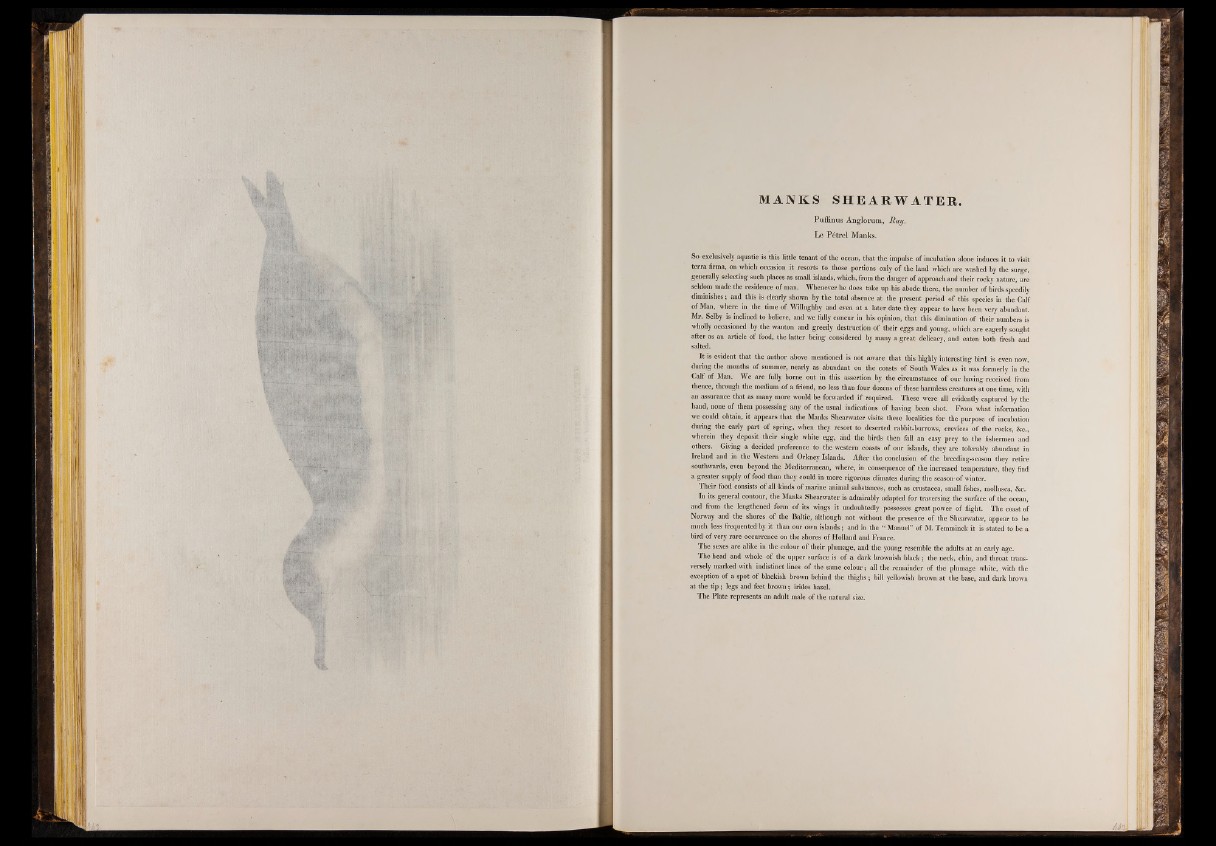
I l
I 11 Pi I
1
MANKS SH E A RWA T E R .
PuiEnus Anglorum, Ray.
Le Pétrel Manks.
So exclusively aquatic is this little tenant of the ocean, that the impulse of incubation alone induces it to visit
terra firma, on which occasion it resorts to those portions only of the land which are washed by the surge,
generally selecting such places as small islands, which, from the danger of approach and their rocky nature, are
seldom made the residence of man. Whenever he does take up his abode there, the number of birds speedily
diminishes ; and this is clearly shown by the total absence at the present period of this species in the Calf
of Man, where in the time of Willughby and even at a later date they appear to have been very abundant.
Mr. Selby is inclined to believe, and we fully concur in his opinion, that this diminution of their numbers is
wholly occasioned by the wanton and greedy destruction of their eggs and young, which are eagerly sought
after as an article of food, the latter being considered by many a great delicacy, and eaten both fresh and
salted.
It is evident that the author above mentioned is not aware that this highly interesting bird is even now,
during the months of summer, nearly as abundant on the coasts of South Wales as it was formerly in the
Calf of Man. We are fully borne out in this assertion by the circumstance of our having received from
thence, through the medium of a friend, no less than four dozens of these harmless creatures at one time, with
an assurance that as many more would be forwarded if required. These were all evidently captured by the
hand, none of them possessing any of the usual indications o f having been shot. From what information
we could obtain, it appears that the Manks Shearwater visits these localities for the purpose of incubation
during the early part of spring, when they resort to deserted rabbit-burrows, crevices of the rocks, &c.,
wherein they deposit their single white egg, and the birds then fall an easy prey to the fishermen and
others. Giving a decided preference to the western coasts of our islands, they are tolerably abundant in
Ireland and in the Western and Orkney Islands. After the conclusion of the breeding-season they retire
southwards, even beyond the Mediterranean, where, in consequence of the increased temperature, they find
a greater supply of food than they could in more rigorous climates during the season'of winter.
Their food consists of all kinds of marine animal substances, such as Crustacea, small fishes, mollusca, &c.
In its general contour, the Manks Shearwater is admirably adapted for traversing the surface of the ocean,
and from the lengthened form of its wings it undoubtedly possesses great power of flight. The coast of
Norway and the shores of the Baltic, although not without the presence of the Shearwater, appear to be
much less frequented by it than our own islands ; and in the “ Manuel” of M. Temminck it is stated to be a
bird of very rare occurrence on the shores of Holland and France.
The sexes are alike in the colour of their plumage, and the young resemble the adults at an early age.
The head and whole of the upper surface is of a dark brownish black ; the neck, chin, and throat transversely
marked with indistinct lines of the same colour ; all the remainder of the plumage white, with the
exception of a spot of blackish brown behind the thighs ; bill yellowish brown at the base, and dark brown
at the tip ; legs and feet brown ; irides hazel.
The Plate represents an adult male of the natural size.